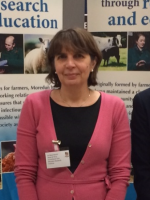Introduction
The incidence and prevalence of the major endemic diseases in UK livestock is surprisingly difficult to determine for a variety of reasons including , lack of specific diagnostic tests and the lack of a unified system for recording disease whether it be diagnosed by government labs, private vets, at slaughter or even on the farm. Such knowledge however is required for accurate evaluation of the economic impact of endemic diseases, their contribution to greenhouse gas emissions, to enable implementation of effective disease control strategies and to comply with certain regulations for maintaining trade. Improved estimates may be achieved by a number of means, such as, broadening the data sources used, adding new information (from industry, government-led schemes, multi-centre collaborations) and extending current surveillance activities. This information informs and supports current Scottish Government (SG) policy and its development in areas that include, for instance, improved use of data for targeted advice and control measures in the end stages of the current BVD eradication scheme, enhanced surveillance and the promotion of the positive health status of Scottish livestock. The information can also be used to encourage industry-led activities.
Work in this programme of research brings together epidemiologists, experts in diagnostics and disease management, statisticians and socio-economists allowing an integrated approach to the problems identified above. Working with other scientists, food and farming industry representatives and Scottish Government policy makers a number of important endemic diseases have been identified and prioritised for research. These include: maedi-visna (MV), ovine pulmonary adenomatosis (OPA), tick-borne diseases (TBDs); wormer resistance in Nematodirus battus, a parasitic disease ofsheep; paratuberculosis (paraTB) and Bovine Virus Diarrhoea (BVD) in cattle; the use of antimicrobial in pigs and cattle; and biosecurity best practise measures for small to medium scale producers.
Aim of Research
Disease has a detrimental effect on animal health and welfare and causes substantial losses in production. In order to assess the effectiveness of control measures and determine their economic impact, a quantification of the level of disease and/ or health status is needed. This research aims to provide improved baseline measurements of disease and health status (current and future) as well as cost-effective biosecurity management tools through investigating specific areas: estimates of health status and disease prevalence by optimising the use of data already available; the application of novel diagnostic strategies for diseases not currently investigated; by evaluating the impact of a reduction in antimicrobial usage on livestock health status; and by assessing the cost-effectiveness of biosecurity recommendations for small scale producers. Information collated through this work will benefit a range of people from government policy-makers to the general public. The impact of this work will come from providing improved information on where and when priority animal diseases occur and how they can be controlled.
Progress
2021 / 2022
During the year, further progress was made in developing methods to evaluate the health status of Scottish livestock and to communicate these findings to stakeholders. We achieved the original aim to generate improved measurements of disease and health status and derive cost-effective biosecurity management tools. We produced new estimates of the incidence of paratuberculosis, OPA, and PRRS; through stake-holders meetings we obtained new data on AMU in cattle, sheep and pigs; produced an analytic method to enhance understanding of herd BVD status; investigated biosecurity and campylobacter control in poultry and supported the investigations of Avian influenza outbreaks. We developed new diagnostic techniques (BZ resistance in N. battus and tick-borne pathogens) and applied them in the field. We maintained effective communications with industry livestock sectors and policy colleagues as well as the public.
Highlights:
- To estimate the presence of tick-borne diseases in tick exposed livestock, serum samples previously confirmed positive for other tick-borne diseases were screened by molecular methods to detect the agent of Q fever. No Q fever was detected, indicating that in animals recently challenged by ticks, as indicated by other test results, only a lower number are actively infected and that persistence of the bacterial nucleic acid in serum is likely to be extremely short lived. However, this work delivered several new diagnostic possibilities for Q fever testing, including testing of fixed samples, rapid testing of fresh material and precise quantification of bacterial load. Furthermore, this work demonstrated the adaptability of available SEFARI high containment laboratories. The methodologies developed during this work shows that in SEFARI institutes have the specialised personnel and facilities required to screen for new and emerging zoonotic diseases, capability that can be employed again in outbreak responses, locally and with a short turnaround time.
- To understand the role of deer in the dissemination of N. battus infection, we sampled a number of farmed deer showing that, as already observed in wild culled deer, farmed deer had modest faecal egg counts and carried both cattle, and sheep roundworms. The findings need to be considered when developing roundworm control strategies for farmed deer where they are grazing on paddocks that currently have, or have recently held, livestock as the parasites may carry genes for anthelmintic resistance that will make control of these pathogens more difficult.
- To maximise the impact of work on MV & OPA in sheep, as part of the of chronic 'ice-berg' diseases, while contributing to ability to demonstrate health/disease status for trade purposes post-Brexit, we have: presented the research conducted within the Strategic Research Programme (SRP) at the 'Scottish Sheep Industry Conference, RESAS Research' on 18/01/2022; acquired funding for additional knowledge exchange activities – these have included updating the Technical note https://www.sruc.ac.uk/media/uyhnga0i/tn-758-ovine-pulmonary-adenocarcinoma-480035.pdf, webinars SRUC-OPA-flyer.pdf (sheepvetsoc.org.uk) and podcasts (still to be released) as well as numerous farming press releases; and are contributing to the Scottish Government’s Industry-led Working group on the control of OPA.
- The SRP research into the recording of antimicrobial usage (AMU) in Scottish sheep flocks has resulted in: discussions with practising vets that demonstrated enthusiasm within the profession for efforts to improve the measurement and recording of AMU in sheep flocks, despite the acknowledged challenge of client engagement; a number of briefs to inform Scottish Government and others about the findings from the research; a presentation to the sheep industry at the 'Scottish Sheep Industry Conference, RESAS Research' on 18/01/2022; a poster presentation at a European Epidemiology conference ("Core Metrics for Antimicrobial usage in the Scottish Sheep Sector" presented at SVEPM (Belfast, March 2022); and the involvement in a Scottish working group, led by Quality Meat Scotland to determine the best approach to implementation of AMU recording for the Scottish sheep sector, so that the use of these data can be optimised for the industry sector’s benefit.
- To maximise studies into use of existing data sources (e.g. proxies for mortality in cattle & sheep analysis), in collaborative research between researchers working in both the Strategic Research Programme in RD 2.2.2, and Scottish Government’s Centre of Expertise on Animal Disease Outbreaks (EPICIII), we have evaluated the historic coverage of the Disease Surveillance Centre Network in Scotland. We are now in the process of developing a Veterinary Surveillance Intelligence Unit that aims to optimise this network and the increasing amounts of available data sources. This work will continue in a collaboration between the SEFARI institutes and the newly commissioned Centre of Expertise on Animal Disease Outbreaks (EPICIV).
- To explore the associations between AMU, Porcine reproductive and respiratory syndrome virus (PRRS) and Enzootic Pneumonia (EP) status in Scottish pig farms we have gathered data from a cohort of Quality Meat Scotland (QMS) assured farms for the year 2020 which showed that farms affected by both PRRS and EP had higher AMU than farms free from these diseases. Farms tended to be either positive for both or negative to both diseases. More investigations are needed to tease out the real impact of each disease on AMU. Implementing control and eradication measures to control these endemic diseases is likely to translate into a meaningful reduction of antimicrobial use in Scottish pig farms.
- Outputs from SRP research on the structure, demographics and approaches to animal health and biosecurity was used to: collaborate with researchers in the Scottish Government’s Centre of Expertise on Animal Disease Outbreaks (EPICIII) to use sheep movement and official demographic data to assess and improve the interpretation of SRP small-holder and crofter surveys; provide Scottish Government with information about some between-holding movements of sheep which, although not subject to statutory movement recording requirements, are a valuable addition to the overall picture of how sheep move around Scotland and the potential routes of interaction between holding types; inform further studies by social scientists working in the Scottish Government’s Centre of Expertise on Animal Disease Outbreaks (EPICIII).
2020 / 2021
Year 5 was a very challenging year, yet progress was made in further developing methods to evaluate the health status of Scottish livestock and to communicate these findings to stakeholders, notwithstanding the restrictions imposed by the pandemic. Knowledge exchange events were held on line and research briefs produced; communication was maintained with industry and SG policy advisors. Where specific projects had to be delayed, alternative work, and most notably the support of the NHS effort through the provision of additional PCR testing for SARS-CoV-2 took place. Overall, in Year 5 we demonstrated that new tests/statistical approaches can improve the evaluation of livestock health. Frequencies of paratuberculosis in cattle farms was estimated, increased awareness of Ovine Pulmonary Adenocarcinoma among flock-holders demonstrated, evidence on measurement of Antimicrobial usage (AMU) provided and the use of new test to investigate disease prevalence in different population progressed.
Highlights:
- The One Health approach to antimicrobial resistance in humans recommends a reduction in antimicrobial usage (AMU) in livestock, however baselines need to be known to set targets. Estimated baselines of AMU in beef & dairy farms from 4 years of pharmaceutical sales data from a vet practice were published and made available to stakeholder with the following conclusions drawn: overall usage levels suggested that reaching targets at national level is achievable; a number of approaches to calculate antimicrobial usage are available, all have merits but none is perfect; the denominator (herd size) at the herd level based on agricultural census (snapshot) risks being too small for some herds.
- In 2019, the Sheep Antibiotic Guardian Group published a set of flock-level core metrics (https://projectblue.blob.core.windows.net/media/Default/Beef%20&%20Lamb/SHAWG/Sheep-AMU-Metric-document_version-1.0_17Jul19.pdf ) that could be used for flock-level benchmarking and to estimate AMU in the wider sheep sector. In 2020, using two online questionnaires we provided evidence to support anecdotal understanding that neither farmer or veterinarians can provide all of the core metrics required for evaluation. A joint approach with flock-owners, working in conjunction with their vet to calculate and validate the appropriate measure for the amount of antibiotic used (total mg/flock/calendar year) will be needed. Both communities will need further support to provide the core metrics for AMU in sheep flocks.
- Improving the knowledge of PRRS status in Scotland using available data: the data gathered from surveys to estimate PRRS seroprevalence in finishing pigs showed that the national prevalence was high (45-48% across the three surveys) and stable over time (2006-2018). About 70% of the farms did not change their status between samplings. There was a higher concentration of seropositive farms in the North East Scotland region. Collating information on vaccination practices is necessary to classify regions according to their status and to envisage the implementation of regional elimination programmes.
- Ovine Pulmonary Adenocarcinoma (OPA), otherwise known as Jaagsiekte, is a viral disease of sheep that causes slow-growing tumours to develop in their lungs. In 2020, in a collaboration between Moredun and SRUC researchers and SRUC Veterinary Services, sheep flock owners previously involved in a Scottish survey of sheep diseases (2006-2008) were contacted to find out if they had had any additional cases of OPA in their flocks since the original survey. Approximately a fifth of the respondents’ flocks were affected by OPA. There was evidence that the sheep farmers who participated in 2020 had better awareness of the clinical signs of OPA and of appropriate prevention and control strategies than they did in 2006-2008. In addition, almost half of all the participants reported that they had made improvements to their approach to flock health and over a third had made changes to their buying in policy, in the past 12 years. This study has highlighted that awareness of, and knowledge, about this endemic sheep disease has improved and it has identified where opportunities exist for further education and improvement.
As wild deer numbers are increasing it is expected that contact between them and livestock will also increase. Understanding the role that wild deer currently play in the dissemination of livestock parasites may help understand how infections/disease may spread in the future. Analysis of egg count data from different wild deer species showed no statistical difference was detected in the average strongyle faecal egg count between them but the number of nematode species carried by each host species was statistically different. Roe deer were typically being infected with the largest range of nematodes followed by red then sika. Proximity to livestock species at time of cull did not appear to influence the results but not all deer had livestock proximity data associated with them.
2019 / 2020
Work in year 4 has made further progress in identifying, developing and evaluating methods for the effective quantification of the occurrence of endemic diseases and the health status of Scottish livestock populations. The identification of priority diseases, the development of novel diagnostic tests and the extension of surveys of smallholders to different livestock sectors were achieved through targeted consultations (industry stakeholders and farming communities ), dialogue with policy advisors and redefining statistical approaches (including the evaluation of additional data sources). All of these activities will result in robust evidence-base support for policy makers, improved of disease control strategies and effective surveillance with results and outputs to emerge in year 5 and after.
Highlights:
- Biosecurity for small-scale producers: two separate surveys of small-scale keepers of cattle and sheep from the small-holder and crofting communities highlighted some interesting differences and similarities between the two. The responses will be analysed further in the coming year to extract the key messages and lessons that can be applied to help these sectors to engage with the implementation of relevant biosecurity measures and to help Scottish policy makers to tailor their approaches to disease control strategies.
- Optimisation of the use of existing data: a number of the quantitative research studies that have been completed have been recognised as bridging the gap between the theoretical use of existing data sources and operational surveillance activities. Implementation could lead to enhanced surveillance to reduce disease and enhance the health of the Scottish livestock sector. However, as highlighted by the qualitative study, to optimise such a system this will need to be done in a way that ensures the outputs are relevant to the end-users. This will require tailoring as what is relevant to policy advisors differs from that of livestock keepers, and varies between livestock keepers in some sectors.
- Tick-borne encephalitis virus detected in ticks in the UK: surveillance work, supported by SEFARI scientists, detected tick-borne encephalitis virus in ticks from 2 parts of England for the first time. Tick-borne encephalitis (TBE) is an infection spread by tick bites and is endemic in mainland Europe and Scandinavia, as well as Asia. Most people who acquire TBE will not have any symptoms, though it can cause flu-like symptoms and in a small number of cases can progress to more serious disease involving the central nervous system. The risk from TBEV is currently assessed as very low for the general population. The findings are part of ongoing research by Public Health England (PHE) and the Emerging and Zoonotic Infections National Institute for Health Research (NIHR) Health Protection Research Unit at the University of Liverpool.
- The role deer play in dissemination of nematode infections: deer are ubiquitous throughout Scotland and their abundance and/or geographical distribution is considered to be increasing, bringing them in to greater contact with livestock. A Scottish deer health survey (n=1087) was conducted to look at the presence of key livestock pathogens in Red and Roe deer although Fallow and Sika were also examined. Faecal samples were examined for Strongyle and Nematodirus egg counts as well as with Multiplexed Tandem-PCR (cattle and sheep parasite kits) to identify eight economically important nematode genus/species. More than 645 faecal samples were examined for egg counts; ~80% had positive strongyle egg counts, and an additional 10% of the samples contained small numbers of Nematodirus eggs. The most frequent species/genera identified were Oesophagostomum, O. ostertagi and Trichostrongylus. Other species such as T. circumcincta, Haemonchus and Cooperia were also present. This work highlights that deer could be responsible for the dissemination of multiple nematode species to livestock, play a role in the spread of anthelmintic resistance and/or provide a source of refugia.
2018 / 2019
Building on earlier outcomes, work in year 3 has continued to identify, develop and evaluate methods for the effective quantification of the occurrence of specific diseases and the health status of Scottish livestock populations in general. Food and farming industry stakeholders were consulted, statistical approaches defined, data sources evaluated, priority diseases identified, novel diagnostic tests developed and applied and outputs regularly communicated to policy advisors. Studies of antimicrobial usage and its association with health status were extended to different livestock sectors, as were surveys of smallholders. All of these activities will improve the evidence base for policy makers, for the development of disease control strategies and for effective surveillance.
Highlights:
- Understanding Antimicrobial Use : SEFARI scientists, in this and other Scottish Government-funded programmes, are putting together the pieces of the complex One Health jigsaw that is anti-microbial resistance (AMR). Their work in areas of AMR in the environment, food chain, livestock and wildlife populations was showcased to relevant stakeholders and researchers at a recent SEFARI Gateway Responsive Opportunity funded event. This research will assist Scottish policy makers to prioritise action to meet commitments to the new UK Action plan for AMR and so contribute to the realisation of the UK vision for AMR.
- Nematodirus battus in deer and tick borne infections in sheep: In Y3 testing for presence of nematode infections in deer, including the detection of resistance to the chemicals used to treat these infections has continued, as has searching for evidence of tick borne diseases (TBDs) in sheep. The results of this work highlighted the possibility that 1) deer could act as additional reservoirs for nematodes in livestock and that 2) that livestock could act as potential reservoir and be used an indicator for TBDs in multiple animal species, including humans. This information has been discussed at farming events such as North sheep and the Royal Highland Show.
2017 / 2018
Quantification of health status or levels of disease has continued in year 2. This has been achieved through the use of a number of statistical approaches to estimate the incidence of priority diseases, the deployment of novel diagnostic tests in the field, the analysis of antimicrobial sales data and its association with health status and usage and the investigation of awareness levels in small scale poultry producers of the types of biosecurity measures they could employ. . Advances in the design of future surveillance systems have been communicated to various stakeholders including policy makers.
Highlights:
- Combatting drug resistance: Resistance in the roundworm Nematodirus battus to the Benzimidazole (BZ) chemical used to treat infections challenges both the sustainability and productivity of livestock keeping. SEFARI researchers have: (1) Demonstrated detection of resistance in N. battus using molecular technologies; (2) Identified multiple genetic mutations for BZ resistance in N. battus populations from across the UK (3) Estimated that 3-5% of individual worms carry the mutations associated with resistance and resistant worms are found on a third of UK farms; and (4) Extended the known risk period of transmission beyond the traditional spring months.
- SEFARI researchers pull together to tackle antimicrobial usage and resistance: Synergy across the government funded research has led to the initiation of a series of workshops on antimicrobial use and resistance (the first was held 10th November 2017 in Dundee). This was to better coordinate the work and provide a stronger, more visible platform for stakeholders (policy; industry; science) as we tackle one of the grand challenges for agriculture.
- Engaging with poultry keepers: To achieve effective control of poultry disease outbreaks, it is fundamental to understand backyard and small poultry producers’ attitudes to the management and welfare of their birds and to the biosecurity practices they implement. Improved knowledge of these practices will help to ensure that any Government policies are effective. Two surveys, reported via a webinar, targeted two different populations: backyard poultry keepers (up to 50 birds of any species) and small to medium commercial egg producers (>50 but <32,000 hens). The surveys coincided with an outbreak of avian influenza providing first-hand information about how this outbreak was dealt with by poultry keepers.
2016 / 2017
The effectiveness of animal disease control strategies relies on the collection of appropriate data. In Year 1 of this research we laid the foundation for the determination of improved measures of health status, be it via better estimates of disease prevalence, the optimisation of existing data, the establishment of new diagnostic tests, the improvement of data recording, the analysis of the relationship between disease status and antimicrobial use, or investigation of the cost-effectiveness of biosecurity. In all these objectives stakeholders, including farmers, public, industry, science audience and policy makers were consulted and/or informed of the progress achieved.
Highlights:
- Finding BVDV PIs: ScotEID[CM1] data has been employed to answer questions that will inform the next phase of the Scottish Government’s mandatory Bovine Viral Diarrhoea eradication scheme. A model has been developed that incorporates the BVD Eradication Scheme’s testing protocol, the peculiarities of the diagnostic test used to identify infected animals and the virus epidemiology. This was developed because no test can be 100% accurate and the information from the model will be used to ensure diagnosticians have the best chance of detecting whether or not farms are free of disease.
- Identification of farms with Nematodirus battus infections: Nematodirus battus is a roundworm that typically affects young grazing livestock, causing acute diarrhoea, subsequent dehydration and in acute cases, death. The examination of faecal samples sourced from 300 UK farms has allowed the detection of of N. battus in areas where it had not previously been reported and allowed advice on what to do about it to be given to the farmers. In addition, the same samples have been archived to be tested at later stages for the presence/absence of mutations that are implicated with resistance to the chemicals normally used to treat this roundworm. This in turn will be used to draw up a map of resistant worms across the UK.
- A series of Livestock Health Roadshow events were delivered across the country in October and November 2016; including events in Aberfeldy and Perth in Scotland and Rhug in North Wales, on improving productivity and sustainability in sheep and cattle through better control of endemic disease. These were held in conjunction with Livestock Health Scotland. Topics discussed included sustainable worm control, vaccine programmes in livestock production, biosecurity, winter feeding and micronutrition.
- An animated film entitled ‘War of the Worms’ was launched at the 2016 Royal Highland Show to highlight the development and spread of resistance to worm control chemicals as well as the messages on sustainable methods of parasite worm control (https://vimeo.com/180186122?lite=1).
Future Activities
Novel information acquired during the six year programme underpinned one successful Veterinary Medicines Directorate funded grant (risk of transmission of roundworms and anthelmintic resistance genes through Livestock trade) and an ERA-NET ICRAD (TBDs) application. We will continue the analysis and presentation of research findings related to the emergence of Benzimidazole resistance in N. battus, the occurrence of novel epidemiological changes in this species and how this can be managed sustainably on UK sheep farms. A continuation of the research on ticks and tick-borne disease was specifically requested for the new research programme (2022-2027) and will be delivered through an interdisciplinary, inter SEFARI institutes and University collaboration. This will be integrated with molecular tools to identify ticks and zoonotic tick-borne pathogens and spatio-temporal modelling expertise to understand how tick distributions and movement opportunities shape risk of tick and pathogen contact with humans and livestock.
A Veterinary Surveillance Intelligence Unit that aims to optimise the networks created in this programme and the increasing amounts of available data sources will be developed in a collaboration between the SEFARI institutes and the newly commissioned Centre of Expertise on Animal Disease Outbreaks (EPICIV).
Recent Strategic Research Programme (SRP) research on antimicrobial usage and recording in Scottish livestock sectors will inform activities within the new SRP project Programme (in Project SRUC-A2-3) to help to inform antimicrobial stewardship and optimal use. We will explore the relationship in changes between national and sector level collated record of AMU and antimicrobial resistance over time and space to contribute to l understanding the flow of AMR from livestock production to the environment and humans at a systems-level.
Selected Outputs
- "Ecology of BVD with implications for transmission" at the Chicago held symposium (Dec 2016), "Evolution and ecology of BVDV: Implications for Health and Control".
- Cross SRUC/industry paper "A preliminary survey of lamb losses (black loss) in Highland Sheep flocks" published in the Vet Record (https://veterinaryrecord.bmj.com/content/180/8/197.1)
- Blowfly strike in sheep: self help surveillance for shepherds is unsustainable (https://veterinaryrecord.bmj.com/content/180/11/280.1.full)
- Louping ill best practice guidelines published on Moredun website (https://www.moredun.org.uk/sites/default/files/documents/diseases/louping_ill_best_practice_booklet.pdf)
- Briefing on ticks and tick borne disease during the Moredun press day (12 Dec17). Excerpts from the interview conducted on press day have been published in 3 industry (https://www.moredun.org.uk/research/diseases/ticks-tickborne-diseases) and 1 national newspaper.
- AMR: Detection of Extended Spectrum Beta-Lactam (ESBL), AmpC and carbapenem resistance in Enterobacteriaceae in beef cattle in Great Britain in 2015 (https://onlinelibrary.wiley.com/doi/full/10.1111/jam.14211)
- Assessing the disease biosecurity of backyard poultry keepers (https://www.sruc.ac.uk/downloads/download/1303/assessing_the_disease_biosecurity_of_backyard_poultry_keepers)
- Engagement with small-scale egg and poultry producers on disease must be improved (https://www.sruc.ac.uk/news/article/2017/engagement_with_small-scale_egg_and_poultry_producers_on_disease_must_be_improved?utm_source=SRUC+Staff+%28plus+SAC+Consulting+segment%29&utm_campaign=0369fbc631-EMAIL_CAMPAIGN_31_01_2018&utm_medium=email&utm_term=)
- The SCOPS manual has been updated. A scientific manuscript has been submitted and is awaiting internal review. https://www.scops.org.uk/
- A fatal case of Louping ill in dog: (https://www.sciencedirect.com/science/article/pii/S0021997518302032)
- Tick borne diseases: bridging the gap between surveillance and research (https://www.moredun.org.uk/news/delivering-excellence-veterinary-surveillance-and-research-scotland)
- Of sheep, sentinels and surveillance; what is the new "normal”? Vet Record. Invited commentary http://dx.doi.org/10.1136/vr.l3057
- Improving the utility of voluntary ovine fallen stock collection and laboratory diagnostic submission data for animal health surveillance purposes: a development cycle. Frontiers in Veterinary Science https://doi.org/10.3389/fvets.2019.00487
- Exploring the longitudinal dynamics of herd BVD antibody test results using model-based clustering. https://doi.org/10.1038/s41598-019-47339-6
- Denominators for national estimates of antimicrobial use may not work for herds: Poster https://aacting.org/aacting-conferences/
- Difficulties in estimating usage of antimicrobials based on sales to beef & dairy farms & associated denominator data from a UK veterinary practice: Proceedings https://ecvph.org/sites/default/files/paragraph-documents/Proceedings%20ECVPH%202019%20Final%20pub.pdf
- Scottish Pig Health Network: making better use of data for health improvements. https://uk.osgeo.org/foss4guk2019/FOSS4GUK_2019_Abstracts.pdf
- Exploring the attitudes of backyard poultry keepers to health and biosecurity https://doi.org/10.1016/j.prevetmed.2019.104812
- The first detection of tick-borne encephalitis virus in the UK, DOI/10.3201/eid2601.191085.
- Cervids as sentinel-species for tick-borne encephalitis virus in Norway - A serological study, DOI: 10.1111/zph.12675.
- High mortality in a sheep flock caused by coinfection of louping ill virus and Anaplasma phagocytophilum, Veterinary Record Case reports, http://dx.doi.org/10.1136/vetreccr-2019-000980.
- Humphry RW, Henry MK, Reeves A, Correia-Gomes C, Innocent GT, Smith R, Mason CS, Gunn GJ, Tongue SC. Estimating antimicrobial usage based on sales to beef and dairy farms from UK veterinary practices. Vet Rec. 2021 Jul;189(1):e28. doi: 10.1002/vetr.28. Epub 2021 Jan 21. PMID: 33729562.
- Ytrehus B., Rocchi M., Brandsegg H., Turnbull D., Miller A., Pedersen H.C., Kålås J.A., Nilsen E.B. Louping-ill virus serosurvey of willow ptarmigan (Lagopus lagopus lagopus) In Norway. J. of Wildlife Diseases, 57(2):282-291 (2021). https://doi.org/10.7589/JWD-D-20-0006
- Correia-Gomes C., Henry M. K., Reeves A., Sparks N.. Management and biosecurity practices by small to medium egg producers in Scotland. British Poultry Science, 62 (4) (2021) https://doi.org/10.1080/00071668.2021.1894635
- Video: Bishop H., Hall E., Smallholders and Crofters Survey findings as presented at the Smallholders Festival October 2020 https://www.youtube.com/watch?app=desktop&v=FZDgXhOqez0
-
There are also two preliminary articles raising awareness of the sheep antimicrobial use survey
Survey on antimicrobial use in sheep
Sheep antibiotic use survey - Management and biosecurity practices by small to medium egg producers in Scotland https://doi.org/10.1080/00071668.2021.1894635
- F. Olsthoorn, H. Sprong, M. Fonville, M. Rocchi, J. Medlock, L. Gilbert & J. Ghazoul (Aug 2021). Occurrence of tick-borne pathogens in questing Ixodes ricinus ticks from Wester Ross, Northwest Scotland. Parasites Vectors 14, 430 (2021). https://doi.org/10.1186/s13071-021-04946-5
- L.A. Melville, G. Innocent, J. Van Dijk, S. Mitchell, D.J. Bartley (2021). Descriptive analysis of nematode management practices and Nematodirus battus control strategies on UK sheep farms. The
- Veterinary Record, Volume189, Issue9, 6/13 November 2021. http://dx.doi.org/10.1002/vetr.775
- Melville L.A. et al. (2022). Assessing farmer perceptions and decision-making choices around nematode epidemiology and control in a changing climate. 15th International Congress of Parasitology, Copenhagen, August 2022. Oral presentation.
- D. Bartley (2021). Perceptions and attitudes to sustainable roundworm control by European sheep farmers. 28th International Conference of the World Association for the Advancement of Veterinary Parasitology, Dublin, July 2021. Oral presentation.
- Melville L.A. (2021). Future Anthelmintic Resistance Messages: Do experts and producers agree? 28th International Conference of the World Association for the Advancement of Veterinary Parasitology, Dublin, July 2021. Oral presentation.




